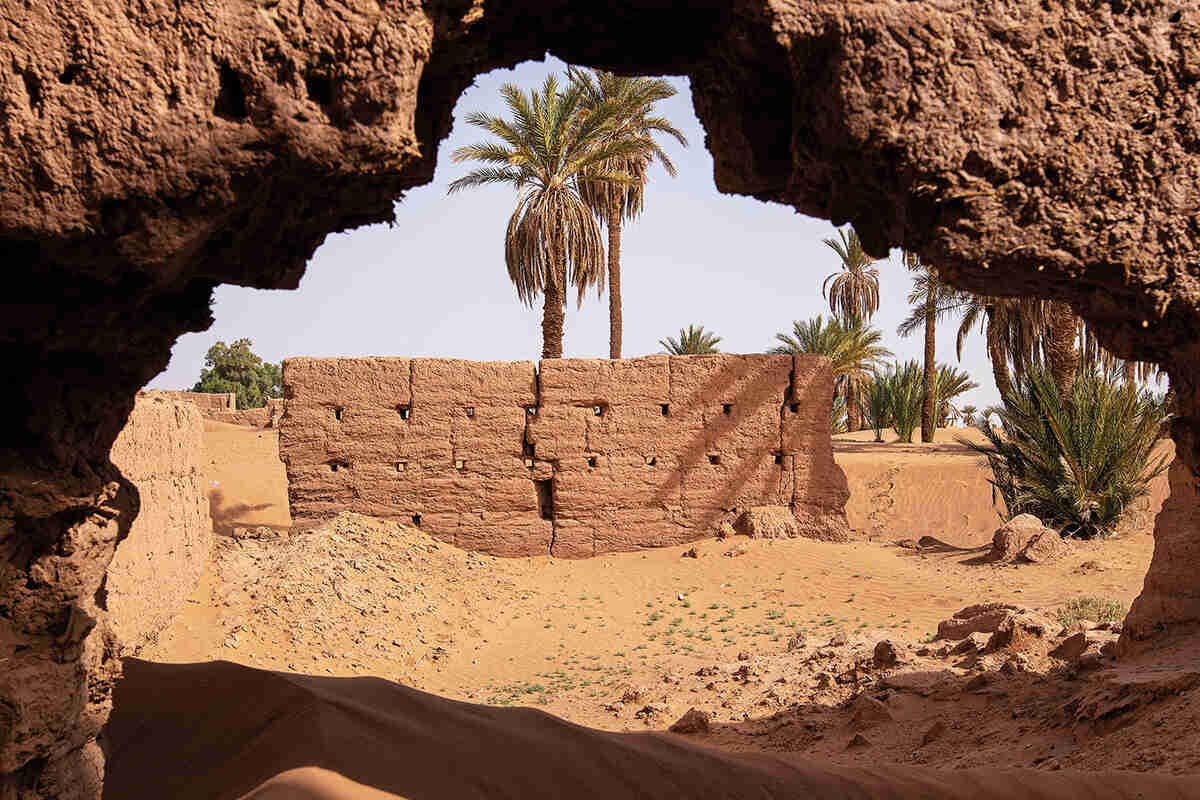
In Morocco, oases that have harboured life for centuries are under threat
Words by Matteo Fagotto, Images by Matilde Gattoni
The nature is so beautiful here. I come to this place whenever I need to calm down or collect my thoughts,’ says Mohamed Laaziz as he leads us around the expanse of palm trees and farm plots that surrounds his house. ‘Sometimes I just like to sit and listen to the birds chirping.’
Showing people around the oasis where he was born is one of Laaziz’s favourite pastimes. As he navigates expertly among the parcels of land, he introduces us to the many secrets of the palm groves, pointing to the crops and other plants hidden behind them, and explaining how to distinguish a female from a male palm tree.
A 52-year-old date trader with a contagious laugh, Laaziz is from Tamegroute, a town of 21,000 and one of the many oases that dot the Draa River valley in southern Morocco. When he was a child, his family fields were ripe with all manner of fruit trees and vegetables. Crucially, date palms – the source of the oasis’s main livelihood – were plentiful. ‘During harvest season, every family would collect more than a tonne of dates,’ he remembers, a broad smile brightening his face. ‘Then, at night, all the kids would gather around the fireplace to listen to grandma’s scary stories.’
Young Laaziz would spend entire afternoons swimming with his friends in the cold river water flowing down from the Atlas Mountains. Nowadays, the same river that once brought life to c is dry and filled with bushes. ‘The Draa gets only three or four months of water per year. This year, we got none,’ he says. The lively, verdant oasis in which he grew up is now a shadow of its former self, full of abandoned fields and drying trees. ‘It’s been eight years of drought. It makes me sad, but you can’t fight God’s will.’

Oases under threat
For millennia, oases (generally defined as fertile areas in a desert that occur where the water table approaches or reaches the ground surface) have been a living symbol of human ingenuity and sustainable development. Their inhabitants were able to thrive in an environment adapted by people – and amid some of the world’s most hostile climates – by using limited resources to their full potential. ‘Oases were isolated ecosystems,’ explains 27-year-old Abdelkarim Bouarif, an agronomist from the oasis of Skoura. ‘People were forced to produce everything they needed and they did so thanks to a know-how acquired over millennia of experimentation.’
Today, oases still host more than 150 million people all over the world and constitute the foremost ecological barrier against desertification. If they were to disappear, not only would this barrier be lost, but it would also wipe away a civilisation whose teachings – from water management to agricultural and architectural techniques – could prove invaluable in adapting to climate change.
Unfortunately, just like Tamegroute, the world’s oases are on the front lines of an existential battle against climate change. Over the past few decades, rising temperatures and human activities have caused a deadly combination of droughts and desertification that have dramatically affected this unique ecosystem and way of life. The trend is particularly acute in North Africa, one of the world’s driest regions, where temperatures could rise up to 5°C by 2060.
Moroccan oases cover 15 per cent of the country’s surface and host roughly two million people. Most of them lie within a wide desert basin south of the Atlas Mountains, along the caravan routes that used to connect the Sahara with the Mediterranean coast. Their inhabitants are the descendants of the nomadic tribes that colonised these areas in past centuries; they are viscerally attached to this land.
The oasis communities employ a unique agricultural system centred on palm trees, which provide dates and shade from the sun, trapping the humidity necessary to grow orchards, vegetables and forage crops beneath them. This variety of crops used to make oases extremely resilient and adaptable to climatic changes. ‘Pomegranates, apples, apricots, peaches, olives, beans, wheat, barley… Everything can grow in a healthy oasis,’ explains Bouarif. ‘It’s an ode to biodiversity. All plants live in synergy, with the palm tree as the orchestra leader.’
People living in Moroccan oases generally share water among land and households on a rotation basis, sourcing it from aquifers, mountains, rivers, lakes or springs through an intricate array of ancient underground canals called khettaras, which take advantage of inclines and prevent evaporation. Ksars, the traditional villages that dot the Moroccan oases, are built using thick mud walls, which insulate houses from the scorching desert heat and provide natural ventilation.
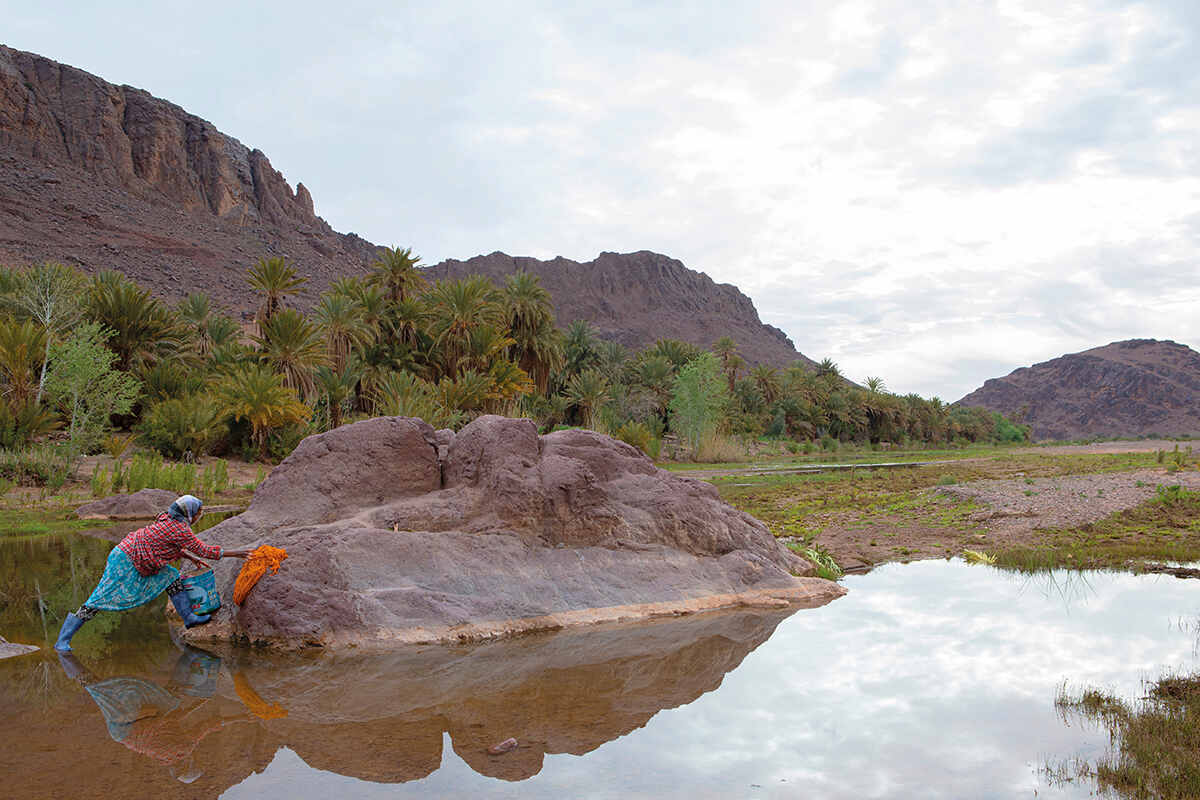
Droughts have always been part of oasis life, but while their previous cyclical patterns allowed communities to endure them by stocking food and carefully managing water resources, now climate change is disrupting the natural pattern, increasing temperatures and extending droughts. In Morocco, a prolonged drought has been ongoing since 2014, forcing countless families to progressively abandon their orchards and palm trees. The country has lost two-thirds of its oases in just a century, and the number of palm trees has fallen from 15 million to just over six million. Lack of economic opportunities is forcing families to emigrate to big cities to work in construction, or as seasonal workers in hotels and restaurants. Hundreds of ksars lie abandoned, crumbling under the weight of the advancing dunes. Walking amid their ruins is like witnessing the slow-motion disappearance of an entire civilisation.
‘Only ten years ago this place was full of crops and greenery. There was life here,’ says Jamaal Akchbab, an environmental activist from Zagora, the biggest city in the Draa valley. ‘Eighty per cent of the people in the area are small-scale farmers who depend on the date trade and this place now is just a graveyard of palms. It’s heartbreaking.’ Droughts have also brought wildfires, which have destroyed tens of thousands of palm trees in a number of regions.
M’hamid el Ghizlane, the furthest of the Draa valley oases before the Sahara and once a symbol of the area’s flourishing date trade, looks like the set of a post-apocalyptic movie. Home to just 8,000 people, over the past few decades the oasis’s area has shrunk by two-thirds, and what remains is being swallowed by the desert. ‘Everything is turning into a cemetery,’ says 51-year-old environmental activist Halim Sbai. ‘When I was a kid, we had palm trees, fruit trees, vegetables… I couldn’t even see our neighbour’s house because of all that greenery. Now there are only dead trunks.’
On a cold winter morning, a group of elders from M’hamid meets under a palm grove on the outskirts of the oasis, right where the desert begins. Dressed in traditional white robes, they start to clap and sing to the rhythm of a drummer. As they dance around a red carpet, they intone an ancestral propitiatory chant to put an end to the drought and bring life back to the oasis. Later, as they gather under a tent to discuss the climate issues affecting M’hamid, they share their dismay at how quickly the oasis has changed.
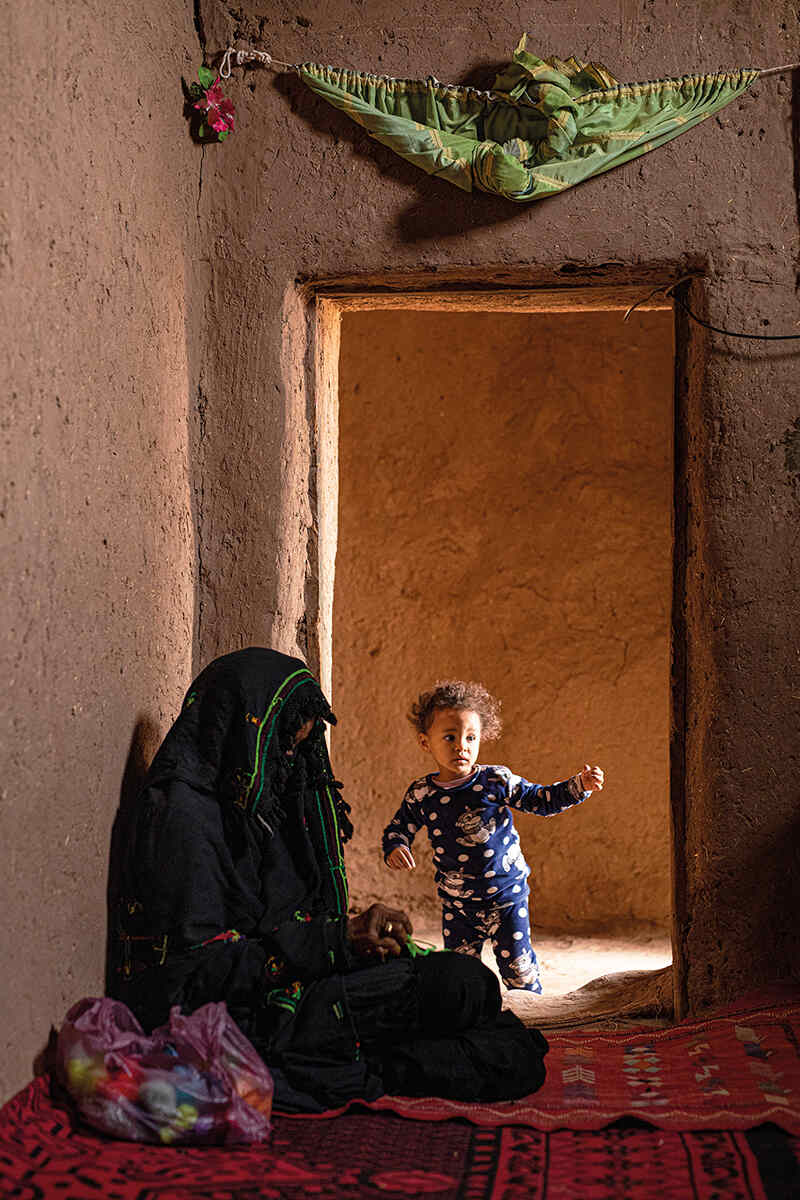
Until the beginning of the 1990s, M’hamid experienced four seasons. Rains were regular in winter, and in autumn the place was abuzz with seasonal labourers and nomads coming in from the desert for the harvest. Truckloads of dates departed daily for big cities such as Marrakesh and Casablanca. Once the season was over, families would celebrate with a flurry of weddings and common meals. ‘Now, the only thing we can do is pray for this drought to end,’ says one of the elders.
Those who remain in M’hamid try to earn a living from tourism, the only viable economic activity left in the region. Countless farmers have morphed into self-taught guides for visitors eager to experience the nearby desert, but the sector isn’t big enough to sustain the whole region. Moreover, the proliferation of hotels is further straining water resources. Sbai, a part-time tourist guide, is cautious. ‘Oases are fragile ecosystems. Tourism has to be well-regulated; otherwise it will just accelerate the death of this place,’ he says.
In 2016, the Moroccan government launched a programme to save the oases. It’s focused on the promotion of local agriculture and handicraft products through local cooperatives; the restoration of traditional irrigation canals; the introduction of breeding techniques to make plants more resistant to drought; and the training of farmers in the cultivation of water-efficient medicinal plants. A simultaneous government push to increase agricultural output all over the country has led to the planting of more than three million palm trees – including artificial plantations that cover some 17,000 hectares.
But this push has also brought investors to the Draa valley who are focused on profitable, high-water-consumption crops such as watermelons. ‘They just rent the land and pump the groundwater. Once they exhaust it, they move to another region,’ says Akchbab.
Water pumps have also prompted some local families to dig private wells to irrigate their land, further exhausting the groundwater reserves and chipping away at the principle of collective water usage – the central social pillar of all oases.
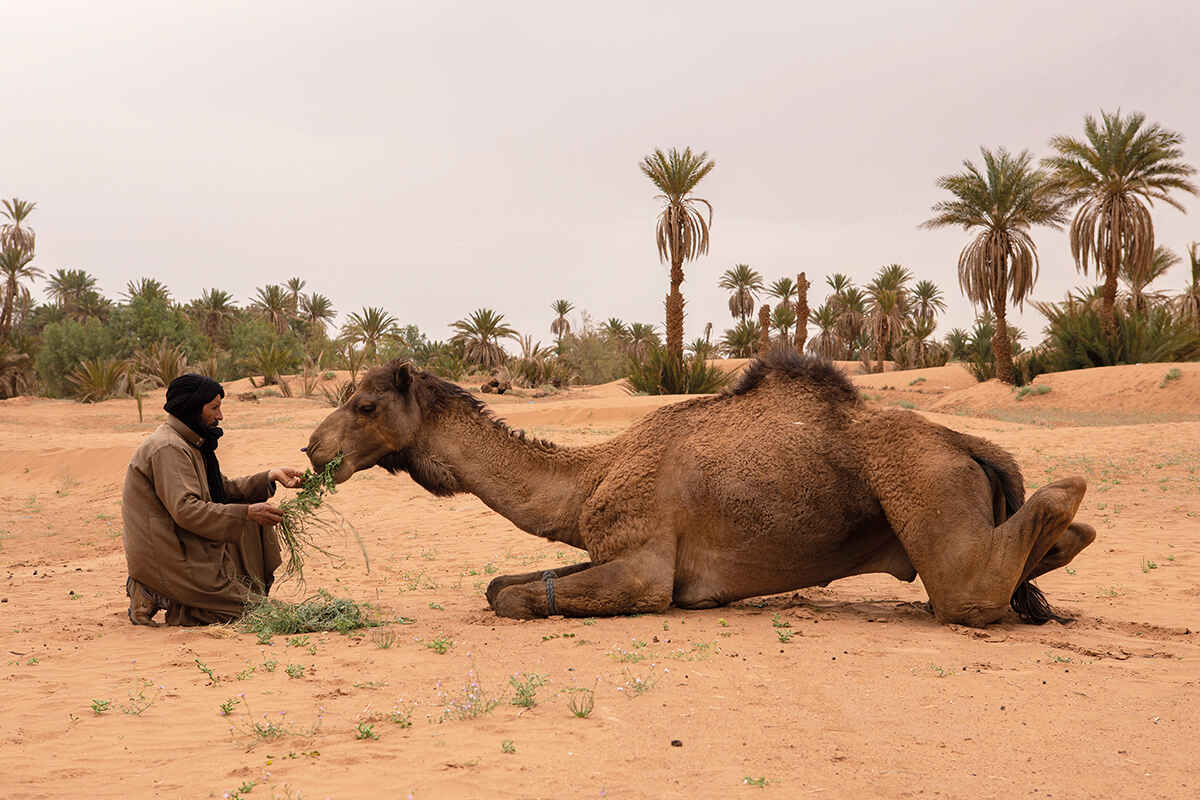
Against the odds
As water becomes scarcer, some oases still thrive. Fint, a secluded oasis of 1,200 people in central Morocco, enjoys water all year round thanks to a river that cuts right across it. Despite being just a few hundreds of kilometres away, its lush green fields are a world apart from the windswept, cracked parcels in M’hamid. With its crystalline pools, waterfalls and creeks, Fint looks like paradise, a preserved example of how these secluded worlds all used to be.
In Skoura, another oasis of roughly 24,000 people located on a plateau close to the Atlas Mountains, the proximity to the mountains guarantees a constant supply of water. Here, the harvesting of dates and olives still plays a key role in the livelihoods of local families. Young and passionate, Bouarif the agronomist knows very well the challenges that oases faces and wants to preserve his by promoting an innovative mix of palm-tree cultivation and sustainable tourism. ‘We have to go back to what our ancestors did,’ he says. ‘It’s the palm tree that brought life to this place. Without it, there would be no oasis.’
Bouarif also encourages local people to reintroduce traditional farming techniques such as crop rotation and the use of local seeds and natural fertilisers. ‘The association of [plant] cultures is also very important,’ he continues. ‘We can rotate leguminous plants, which are rich in nitrogen, and cereals, which enrich the soil with calcium. We can also grow aromatic plants, which keep weeds and other harmful plants at bay.’
As substantial emigration from the oasis cuts the transmission of knowledge from one generation to the next, putting the know-how painstakingly accumulated over centuries at risk, Bouarif’s sees his mission as one of utmost importance. ‘Many farmers don’t apply these traditional techniques anymore. They just want high yields on the most profitable cultures, every year,’ he continues. ‘But in reality, we don’t need chemical fertilisers in the oasis, and we don’t need to over-exploit our land.’
Bouarif applies the same sustainable practices to his family kasbah, which was converted into a boutique guesthouse a few years ago. ‘We source all the vegetables we need from our parcels and from the local market, so that we can sustain local peasants,’ he explains. ‘And we use the discarded pool water to irrigate our fields.’ Bouarif loves to take visitors for a walk in the palm groves and explain how an oasis functions. By doing so, he also hopes to raise awareness about the plight of the oases in Morocco.
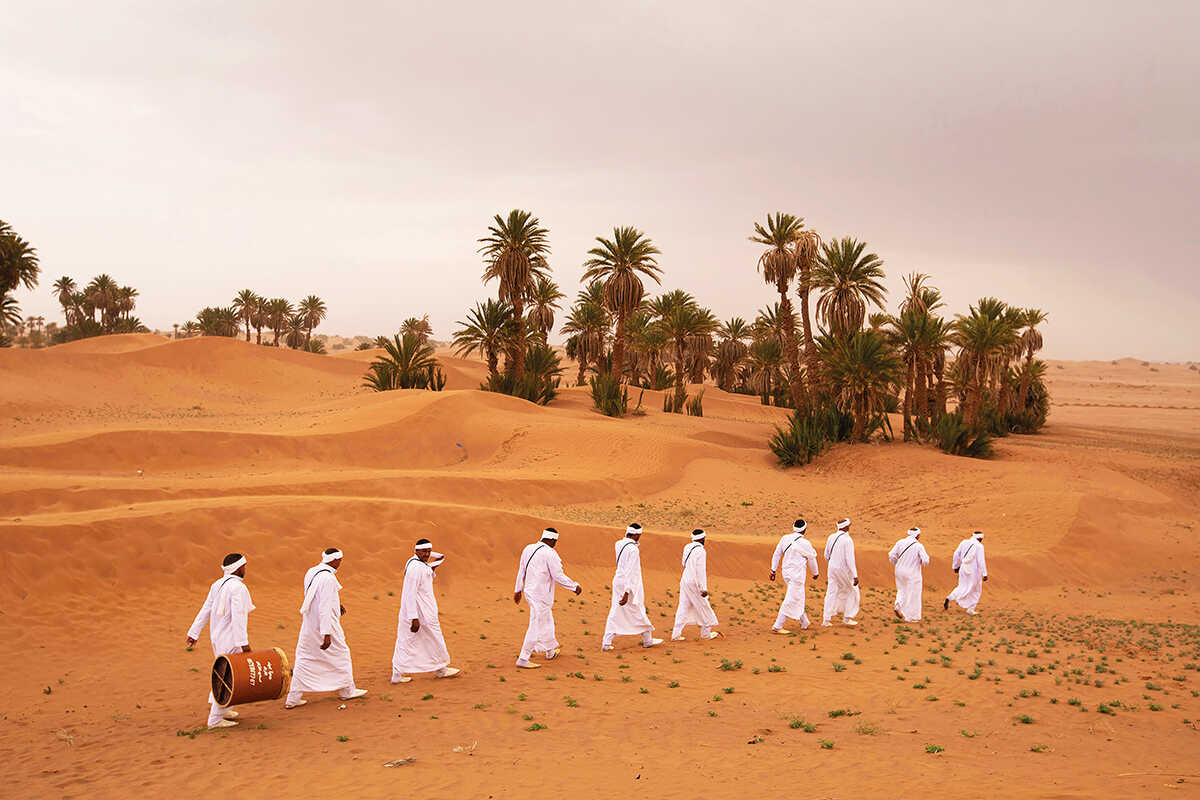
Passing knowledge on
Back in M’hamid, the drought has degraded the palm groves to the point where taking care of them has become almost impossible. Sbai is trying to at least salvage the oasis’s rich history, which is still passed orally from one generation to the other through songs and centuries-old poems. Every weekend, dozens of children and adolescents from M’hamid gather at Sbai’s music school to sing and learn.
‘These poems speak about love, the desert and the beauty of oasis life,’ explains Rashid Berazougui, a 35-year-old guitarist and music teacher, who learnt them from his mother when he was a child. ‘We have a rich culture that we need to preserve and adapt to the modern world. It’s our heritage and it’s our duty to transmit it.’
Like many other men, both Sbai and Berazougui had the chance to leave M’hamid and seek a better life elsewhere. Both decided to stay and fight for the future of their beloved oasis by instilling that same love for this land in the next generation. ‘We work on our immaterial heritage. It’s the first step to take,’ explains Sbai. ‘Otherwise the youngsters will never even know what an oasis is.’
Despite the challenges, Sbai is still hopeful about the future. ‘It’s going to be a long-term effort, but I love to see the smiles on my people’s faces,’ he explains. ‘In order to save the oases, you first have to take care of the human beings living there. They are the foot soldiers in this battle against desertification and the Sahara is a quick enemy.’




